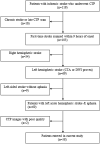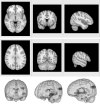Predicting language improvement in acute stroke patients presenting with aphasia: a multivariate logistic model using location-weighted atlas-based analysis of admission CT perfusion scans
- PMID: 20488905
- PMCID: PMC3640318
- DOI: 10.3174/ajnr.A2125
Predicting language improvement in acute stroke patients presenting with aphasia: a multivariate logistic model using location-weighted atlas-based analysis of admission CT perfusion scans
Abstract
Background and purpose: Prediction of functional outcome immediately after stroke onset can guide optimal management. Most prognostic grading scales to date, however, have been based on established global metrics such as total NIHSS score, admission infarct volume, or intracranial occlusion on CTA. Our purpose was to construct a more focused, location-weighted multivariate model for the prediction of early aphasia improvement, based not only on traditional clinical and imaging parameters, but also on atlas-based structure/function correlation specific to the clinical deficit, using CT perfusion imaging.
Materials and methods: Fifty-eight consecutive patients with aphasia due to first-time ischemic stroke of the left hemisphere were included. Language function was assessed on the basis of the patients admission and discharge NIHSS scores and clinical records. All patients had brain CTP and CTA within 9 hours of symptom onset. For image analysis, all CTPs were automatically co-registered to MNI-152 brain space and parcellated into mirrored cortical and subcortical regions. Multiple logistic regression analysis was used to find independent imaging and clinical predictors of language recovery.
Results: By the time of discharge, 21 (36%) patients demonstrated improvement of language. Independent factors predicting improvement in language included rCBF of the angular gyrus GM (BA 39) and the lower third of the insular ribbon, proximal cerebral artery occlusion on admission CTA, and aphasia score on the admission NIHSS examination. Using these 4 variables, we developed a multivariate logistic regression model that could estimate the probability of early improvement in aphasia and predict functional outcome with 91% accuracy.
Conclusions: An imaging-based location-weighted multivariate model was developed to predict early language improvement of patients with aphasia by using admission data collected within 9 hours of stroke onset. This pilot model should be validated in a larger, prospective study; however, the semiautomated atlas-based analysis of brain CTP, along with the statistical approach, could be generalized for prediction of other outcome measures in patients with stroke.
Figures



Similar articles
-
Location-weighted CTP analysis predicts early motor improvement in stroke: a preliminary study.Neurology. 2012 Jun 5;78(23):1853-9. doi: 10.1212/WNL.0b013e318258f799. Epub 2012 May 9. Neurology. 2012. PMID: 22573641 Free PMC article.
-
CT perfusion mean transit time maps optimally distinguish benign oligemia from true "at-risk" ischemic penumbra, but thresholds vary by postprocessing technique.AJNR Am J Neuroradiol. 2012 Mar;33(3):545-9. doi: 10.3174/ajnr.A2809. Epub 2011 Dec 22. AJNR Am J Neuroradiol. 2012. PMID: 22194372 Free PMC article.
-
Role of recanalization in acute stroke outcome: rationale for a CT angiogram-based "benefit of recanalization" model.AJNR Am J Neuroradiol. 2008 Sep;29(8):1471-5. doi: 10.3174/ajnr.A1153. Epub 2008 Jul 3. AJNR Am J Neuroradiol. 2008. PMID: 18599577 Free PMC article. Clinical Trial.
-
Theoretic basis and technical implementations of CT perfusion in acute ischemic stroke, part 2: technical implementations.AJNR Am J Neuroradiol. 2009 May;30(5):885-92. doi: 10.3174/ajnr.A1492. Epub 2009 Mar 19. AJNR Am J Neuroradiol. 2009. PMID: 19299489 Free PMC article. Review.
-
Automated Processing of Head CT Perfusion Imaging for Ischemic Stroke Triage: A Practical Guide to Quality Assurance and Interpretation.AJR Am J Roentgenol. 2021 Dec;217(6):1401-1416. doi: 10.2214/AJR.21.26139. Epub 2021 Jul 14. AJR Am J Roentgenol. 2021. PMID: 34259036 Review.
Cited by
-
Investigating Aphasia Recovery: Demographic and Clinical Factors.Brain Sci. 2023 Dec 21;14(1):7. doi: 10.3390/brainsci14010007. Brain Sci. 2023. PMID: 38275512 Free PMC article.
-
Location-weighted CTP analysis predicts early motor improvement in stroke: a preliminary study.Neurology. 2012 Jun 5;78(23):1853-9. doi: 10.1212/WNL.0b013e318258f799. Epub 2012 May 9. Neurology. 2012. PMID: 22573641 Free PMC article.
-
Poor Outcomes Related to Anterior Extension of Large Hemispheric Infarction: Topographic Analysis of GAMES-RP Trial MRI Scans.J Stroke Cerebrovasc Dis. 2020 Feb;29(2):104488. doi: 10.1016/j.jstrokecerebrovasdis.2019.104488. Epub 2019 Nov 29. J Stroke Cerebrovasc Dis. 2020. PMID: 31787498 Free PMC article.
-
Relation between aphasia and arcuate fasciculus in chronic stroke patients.BMC Neurol. 2014 Mar 8;14:46. doi: 10.1186/1471-2377-14-46. BMC Neurol. 2014. PMID: 24607148 Free PMC article.
-
The Progress of Functional Magnetic Resonance Imaging in Patients with Poststroke Aphasia.J Healthc Eng. 2022 Apr 21;2022:3270534. doi: 10.1155/2022/3270534. eCollection 2022. J Healthc Eng. 2022. Retraction in: J Healthc Eng. 2023 Sep 27;2023:9813403. doi: 10.1155/2023/9813403. PMID: 35494510 Free PMC article. Retracted. Review.
References
-
- Paolucci S, Antonucci G, Pratesi L, et al. . Functional outcome in stroke inpatient rehabilitation: predicting no, low and high response patients. Cerebrovasc Dis 1998; 8: 228– 34 - PubMed
-
- Black-Schaffer RM, Osberg JS. Return to work after stroke: development of a predictive model. Arch Phys Med Rehabil 1990; 71: 285– 90 - PubMed
-
- Laska AC, Hellblom A, Murray V, et al. . Aphasia in acute stroke and relation to outcome. J Intern Med 2001; 249: 413– 22 - PubMed
-
- Lazar RM, Speizer AE, Festa JR, et al. . Variability in language recovery after first-time stroke. J Neurol Neurosurg Psychiatry 2008; 79: 530– 34 - PubMed
-
- Nakagawa T, Murata Y, Kojima T, et al. . Prognostic value of brain perfusion single-photon emission computed tomography (SPECT) for language recovery in patients with aphasia. Nucl Med Commun 2005; 26: 919– 23 - PubMed
Publication types
MeSH terms
Grants and funding
LinkOut - more resources
Full Text Sources
Medical
